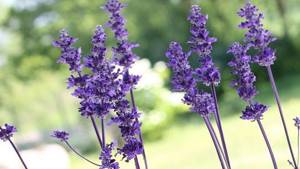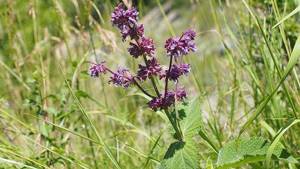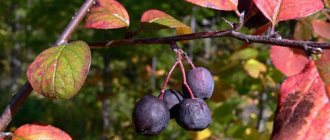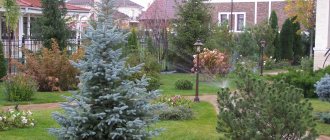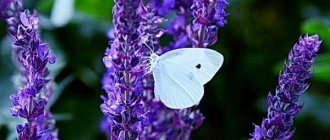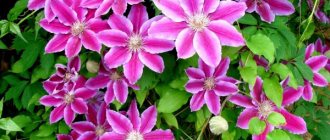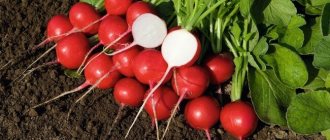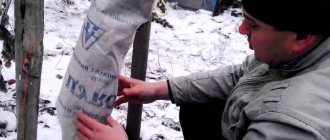Varieties
In nature, there are a large number of varieties of this plant.
The most popular and famous are:
- Medicinal, which reaches 70 cm in height and has a gray-green color. There are several subspecies: Breeze , Aibolit , Nectar and Semko Patriarchal .
- Forest or wild. It is distinguished by its small height and the presence of purple, blue or violet flowers.
- Lugovoy has a yellowish color. The inflorescences are small, but there are a lot of them.
Most often, medicinal and meadow sage are grown in garden plots. But sometimes you come across a forest one.
It is worth considering the most popular varieties that are excellent for planting in a summer cottage.

| Variety | Short description |
| Guarani | The buds are blue, with almost black calyxes, a perennial plant. The height reaches 1.5 meters, and the width of the bush is about 60 cm. |
| Dubravny | The flower grows up to 1 meter and is about 60 cm wide. The flowers can be white, purple or violet. |
| Adhesive | Yellow buds, flower height up to 90 cm with a width of about 50 cm. Likes to be in partial shade, requires moister soil compared to other varieties. |
| lavender leaf | Externally very similar to lavender. It can grow in regions where the air temperature does not drop below -23 degrees. |
| small-leaved | This is an evergreen subshrub that reaches a height of 120 cm. It comes from Mexico and blooms until the end of summer. Requires special care, as it dies at -5 degrees. |
| Fire red | Bright red petals. The flower is up to 30 cm wide and about 70 cm high. It is from South Africa. |
It is possible to use several varieties at once to create an original composition on the site.
Varieties and varieties
About 900 species and subspecies of salvia are known. They differ from each other in aroma, shade of foliage, stems and flowers. Among them there are herbaceous species, shrubs and subshrubs.
Only a few varieties of the plant are grown in cultivation. All of them are used in cooking, medicine and cosmetology.
One of the most popular types of sage is medicinal, or vegetable. The height of this perennial herb ranges from 20 to 70 cm. Its narrow, densely pubescent gray-green foliage has an elongated shape. The stem of the plant is covered with whitish fibers.
The most popular varieties of vegetable sage are the following:
- Breeze - the height of this subshrub reaches 60 cm. The plant has serrated foliage and blue-blue flowers.
- Aibolit - this variety stands out from other representatives of the species with long shoots. They grow up to 120 cm. The wrinkled dark green leaves of salvia are heavily pubescent.
- Nectar - this variety is a bush of medium height, it does not exceed one meter. The heavily pubescent foliage of the plant is light green. The spike-like inflorescences consist of purple or blue flowers.
- Patriarchal Semko - the height of this plant can reach up to 70 cm. It has long leaves that densely cover the stem. The bottom of the stem is woody.
- Kubanets - the variety is a highly branched subshrub. Its height does not exceed 73 cm.
Among the numerous varieties of medicinal sage, there are those that differ from others in their bright appearance. These varieties are called variegated:
- Kew Gold - The plant has pink-purple flowers and bright yellow foliage, which sometimes has small green spots.
- Aurea - against the background of the golden foliage of this variety, its purple-blue flowers look great.
- Tricolor - This sage has bluish-green foliage edged in white, pink and purple.
- Icterina - Salvia foliage of this variety is distinguished by yellow and green colors.
Beneficial properties and harm of woodlice grass
Although sage loves warmth, some species are not afraid of the frosts of the winter in central Russia, and therefore these shrubs grow successfully in one place for several years. These varieties include the following:
- Meadow sage. The height of the plant is from 40 to 70 cm. It has very long, branching inflorescences that adorn the bush from late June to early November. The species grows well in the summer heat, which relieves it of bitterness.
- Oak sage, or forest sage. The height of this salvia depends on the variety, and therefore varies from 30 to 80 cm. The blue-violet, lavender and pink flowers of the plant are collected in long inflorescences, which bloom at the end of June and finish blooming only at the beginning of autumn.
Growing and care
Different varieties of this plant require special care. Thus, the meadow prefers to be on the sunny side and requires moderate watering, while the forest needs more shade and abundant watering.
Despite the diversity, there are several common requirements:
- on sandy loam soil the plant feels better;
- It is recommended to use humus as a fertilizer;
- in winter you need to cover;
- In the spring, pruning is required.
Salvia is considered a heat-loving plant. Therefore, in the northern regions it is grown as an annual plant. They are rarely replanted in the ground again.
Propagation of sage by cuttings
Growing sage at home by cuttings is not difficult.
Cut off part of the shoot up to 10 cm. Tear off small leaves and branches. The shoot is placed in clean water. After a couple of weeks it will produce several roots. When the roots extend to 3 cm, the plant can be moved into the soil.

Useful information from gardeners

Before planting, you need to resolve several important issues. This determines how long the salvia will grow. She can stay in one place for up to eight years.
Selecting a location
You need to choose the sunny side, where the soil is light. Even on rocky or sandy soil, sage will do well. But in the presence of clay, it will not be able to grow normally.
Sage is usually unpretentious. Therefore, it is enough to provide a good drainage system so that it can grow without additional care. But it is recommended not to forget about the flower. With proper care, the buds will be brighter and more beautiful.
It is necessary that the roots do not suffer from lack of air and excess moisture. Otherwise, they will begin to rot and the plant itself will die.
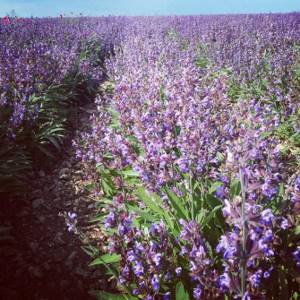
Plant sage in a place where there is more sun, then it will be able to reveal all its beauty
Lighting requirement
Planting in the shade will not kill the plant. However, it will not allow him to reveal all his beauty. Therefore, it is recommended to choose southern areas where there is no shade. The rate of development of sage directly depends on the air temperature outside and sufficient lighting.
If the flower is in a pot, it needs to be provided with maximum peace. It is not recommended to move it and replant it again. All this causes stress, which affects the rate of growth and flowering.
Additional Information
Planting a plant will be successful if you remember a few important nuances:
- sage tolerates drought well;
- the plant does not survive at low temperatures;
- a lot of space is needed, since the flower does not have a highly developed root system, so regular weeding is required;
- for rapid growth and strong flowering, it is necessary to use fertilizers;
- the distance between bushes should not be less than 30 cm.
If potatoes, cabbage or legumes grew in this place before the sage, then there should be no problems with the necessary minerals. It is possible to do without feeding for the first time. However, to obtain the desired effect quickly, it is recommended to use organic fertilizers.
Description
This is a herbaceous bushing plant with pubescent branching stems 40-70 cm high and a rhizome up to 1 cm in diameter. The oblong leaf plates, arranged in pairs, have a rich green color and fine-toothed edges. The lower leaves grow on petioles, the lower ones are sessile. Small purple flowers, collected in spike-shaped inflorescences about 15 cm long, appear from the 2nd year of life. Flowering begins in mid-June and can continue until autumn. The seeds are small brown nuts.
This variety of salvia loves sun, moderate moisture and good drainage. It can grow in its designated place for more than 8 years without stopping flowering. Due to insufficient watering, the growth and branching of shoots is limited. With abundant moisture or under the influence of wind, bushes often collapse, requiring garter.
The leaves and flower parts are rich in essential oils. They can be added to tea, used to flavor rooms, or as a seasoning for meat dishes. For medicinal purposes, water or milk decoctions and alcohol tinctures are used.
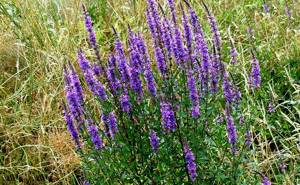
Sage rarely gets sick. Possible pests:
As an ornamental plant, it can be planted independently along a garden path, near a gazebo or play area. Goes well with meadow and garden flowers, herbaceous greens, cereals, vines, and bushes. A popular decorative variety of lush purple sage is Blue Queen.
Read also: Is it possible to drip Kalanchoe for children under one year old?
Landing rules

Usually seeds are used for planting. They can be planted directly in open ground or first in pots (in spring), and then transplanted into the ground. It is necessary to understand that when planting seedlings, the plant is in greenhouse conditions.
That is, it gains altitude quite quickly. However, any manipulation causes stress in the flower. Therefore, you need to be prepared for the death of some seedlings during transplantation into open ground.
If seeds are used immediately, then everything must be done as follows:
- the soil must first be prepared by adding organic fertilizers (humus is best);
- seeds are planted 3 mm deep at a distance of 30 cm from each other;
- For the first 15 to 20 days after planting, the soil should always be moist.
After the emergence of seedlings, it is necessary to switch to watering 1 – 2 times a week. However, at the active growing season, the plant will again need to be systematically irrigated. Mature flowers are watered only when the soil dries out.
Pests and diseases
Sage bushes are resistant to most diseases and pests due to their medicinal properties and spicy aroma.
If the plant is sick, then the reasons for this lie in improper care:
- If the humidity is too high, the grass may become moldy. To avoid such a problem, the gardener needs to ensure that the soil moisture remains moderate and water does not stagnate in the roots. You can cure a plant from mold by spraying it with a sulfur solution.
- Spider mites and slugs can appear on salvia due to too dense plantings. You can save the grass using an infusion of onion peels or garlic, to which laundry soap has been added.
By taking a little time to study the question of how to properly grow sage in open ground, gardeners can get a wonderful, fragrant and healthy plant that will decorate the landscape of their garden plot. This beautiful herb is a very useful remedy that is very popular both in cooking and cosmetology, as well as in folk medicine.
Features of care
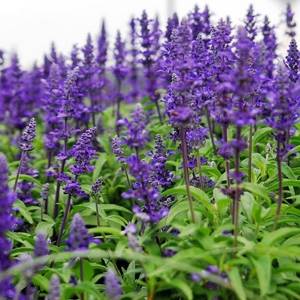
Salvia does not require specific care. However, certain actions need to be performed periodically to make the plant bloom better. So, in the second year it is important to prune. Old shoots are completely removed at a height of 10 cm from the soil. They can be used in a compost pit to make humus. It is best to prune in the fall.
In spring, it is recommended to add nitrogen-containing fertilizers to the soil. They will speed up growth. After pruning, the plant should add phosphorus and potassium. There are many different fertilizers on the market. They must be added according to the instructions.
Expert opinion
Chernyaeva Tatyana Dmitrievna
Absolutely loves gardening and grows only organic vegetables
Ask a Question
Excess nitrogen can burn the roots of the flower, so do not use this mineral too often.
Seedling care
Sage loves nutritious and breathable soil; before planting, it is necessary to add humus, compost, river sand to the soil; it is used to loosen the soil. Before planting a plant in the soil, it needs to choose the right place: it is recommended to plant it where cabbage, potatoes and beans grew.
We recommend that you read Chamomile and gastritis
Care consists of the following:
- Water moderately so that water does not accumulate in the soil, loosen the soil in a timely manner.
- Do not allow weeds to spread in large numbers, as they will cause various diseases to appear on the plant and will also suppress its growth.
- Regular feeding, first requires nitrogen, then organic fertilizers. It is recommended to fertilize with wood ash, which contains a large amount of microelements.
- In winter, sage is covered with leaves that have fallen from the trees to protect it from frost.
- In autumn or early spring, pruning is required for abundant flowering; after flowering, the sage is mowed with a scythe almost to ground level.
- You can replant the plant for its normal growth and flowering.
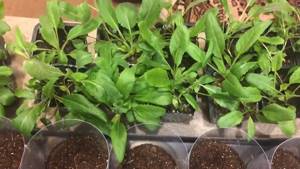
Due to the content of a large amount of essential oils, the plant rarely gets sick. The only vulnerable spot is the root system, which is damaged by heavy watering or frequent rains. If mold appears, it is recommended to treat it with a sulfur solution, strictly following the instructions. The most dangerous pests are thrips, spider mites, and slugs.
Tips from experienced gardeners
There are several important nuances that can make the process of growing sage in a summer cottage easier:
Have you already planted sage in your garden?
Yes in plans!
- watering should be regular only for the first couple of weeks, and then it should be done as needed;
- in the spring it is advisable to add fertilizers for faster growth;
- it is necessary to remove weeds in a timely manner, otherwise the flower will die;
- if you grow sage near other crops that are exposed to parasites, they are likely to go away;
- plants cut in the fall should be put into a compost pit in order to fertilize the soil with the resulting humus in the spring;
- the top and flowers can be used for medicinal purposes, but shoots from annual trees are collected only in early autumn.
Do not use large amounts of fertilizers. The flower is unpretentious, and they are required only to enhance flowering. Excess nitrogen in the soil, which is found in all organic matter, can damage the root system of the flower.
Planting sage
Most types of salvia officinalis love soils of normal acidity (5.5-6.5 pH). Plant sage in a well-lit area. It will grow better on light, fertile soils. Loamy soils are well suited for this.
To enrich the soil before planting sage, humus or compost, as well as phosphorus-potassium mineral fertilizers, are added during digging in the fall. When spring arrives, the soil is leveled and broken with a rake, after which nitrogen fertilizers are also added.
Sage has been growing in its place for more than 8 years. This crop germinates well, so you don’t have to use the seedling method, but sow the seeds directly into the ground in early spring (March - early April, using film) or in the fall under the snow. It doesn’t matter, if you are late with planting, you can sow in May, then there is no need for a film cover for seedlings. In this case, stratification and any other measures for seed germination are not necessary. You can make a ridge for sage, make a furrow and plant the seeds to a depth of no more than 2 cm. Sage grows as a bush, so it is better to leave about 30 cm between plants, and take about 50 cm between rows.
Read also: How can you replace starch in baking?
You should not sow sage after relatives from the Lamiaceae family. The predecessors of sage can be potatoes, cabbage, onions, and legumes.
Wintering
There are two ways to ensure wintering of sage:
- In the southern regions of Russia it is possible to leave roots in the ground. But it is necessary to cover the cut flower with film or a bottle. This method of ensuring safety is relevant if the air temperature does not drop below -10.
- In the rest of the country, the root is dug up. It must be washed and the remaining soil removed. You also need to prepare a box in which the flower will be stored. It is recommended to use sawdust or mulch to ensure preservation.
Expert opinion
Chernyaeva Tatyana Dmitrievna
Absolutely loves gardening and grows only organic vegetables
Ask a Question
It is important that when storing the flower, a constant temperature (5 - 7 degrees) and air humidity are ensured. It is necessary to check the condition of the roots once a month. If necessary, they should be irrigated with a spray bottle.
Reproduction methods
There are several ways to propagate this plant, namely:
- Seeds . When flowering ends, the flowers fall to the ground. It is in them that the seeds ripen. They need to be collected, treated against possible pests and dried. Until spring, they need to be kept in a paper bag, which will allow air access. During the planting period, it is necessary to prepare the soil.
- Division is important if the sage takes root well. To do this, you need to divide a bush that is more than two years old into 2–3 parts. it is important not to damage the root system. After division, you need to transplant the flower to the required place.
- By cuttings . To do this, you should take a woody shoot and put it in water. When it gives roots, it can be planted in the ground. It is necessary that the cuttings be 12–16 cm.
Natural reproduction occurs precisely by seeds. You can assemble them yourself or purchase them in a store. However, store-bought seeds are often modified in such a way that it is impossible to breed new ones from them.
Read the article on the topic: Spinach: growing and caring in open ground
Sage in landscape design
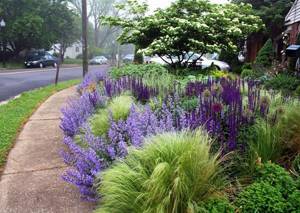
Sage is widely used in landscaping, especially plants with blue flowers.
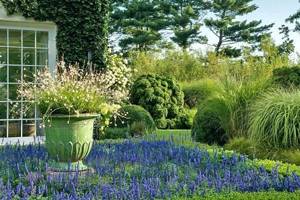
They can visually increase the spaces between plants, as well as give the flowerbed incredible shades.

Sage blooms all summer, so it fits very well into those flower arrangements where many autumn and late plants are collected, for example, asters, heliops, daylilies.
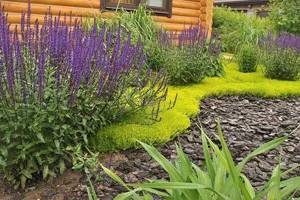
Compositions from sage, daylilies.
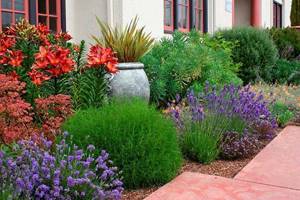
Sage around the seating area.
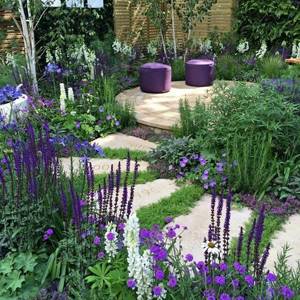
Planting sage seedlings - video
Lush sage (Salvia superba) is a beautiful, abundantly flowering perennial. It is compact, undemanding to care, has a pleasant aroma, and exhibits medicinal properties. Suitable for decorating balconies, terraces, flower beds, mixborders, rock gardens, rockeries, park areas.
Diseases
Sage is a medicinal plant and is therefore considered an excellent insecticide. However, it is susceptible to some diseases.
Therefore, you need to take certain actions to save the flower after detecting signs of disease.

1- Root rot 2- Rust
| Disease | Short description |
| Rust | Dense brown teliosoruses appear on the underside of the leaf. The leaves begin to turn yellow and fall off. It is necessary to remove the affected areas so that the flower does not die. |
| Black root rot | The roots become covered with plaque and gradually turn brown. If the damage is severe, the plant dies. Fungicides must be used to control the fungus. |
| Root rot | The lower part of the stem darkens, rot and plaque gradually appear. It is possible to combat this disease with fungicide solutions. |
Interestingly, parasites rarely infect sage. If for some reason they decide to feast on it, then they will leave after a while. You don't have to do anything special.
Thus, sage is an excellent perennial plant that can delight with its inflorescences for up to 8 years in the southern regions. In other regions of the country, it is used for no more than two years, after which a new one is planted. It is possible to plant it as seedlings, but it is better to immediately plant it in open ground. With proper care, sage will produce large and beautiful buds that will bloom for quite a long time.
Salvia propagation
To grow this wonderful herb, it is better to choose an area located in the open, perhaps with a little partial shade. The soil should be loamy and nutritious, neutral. If the soil is clayey, then sand should be added to it.
In addition, you need to consider that salvia loves warmth and moisture.
There are several ways to propagate sage:
- growing from seeds;
- seedling method;
- dividing the bush;
- cuttings
Seed method
This method is used most often, as sage seeds have good germination.
The site for future planting should be prepared in the fall. The selected area must be carefully dug up with humus or compost, simultaneously adding fertilizers containing potassium and phosphorus.
The planting itself should be carried out in March-April. Before this, the soil needs to be loosened and treated with nitrogen fertilizer. It is better to soak the plant seeds for a day in a growth stimulator, then dry them and sow them in the soil to a depth of 1-2 cm, keeping a distance of 20-30 cm between them. In this case, there should be a distance of 40 to 50 cm between the rows of seeds. Then sow should be covered with film. It can be removed only when warm weather sets in, after the last frost.
If for some reason the sage planting was not carried out in early spring, it can be done in May. The only difference is that the seeds will no longer need shelter.
You can plant sage before winter. To do this, in mid-autumn, plant seeds are planted 4-5 cm deep into the ground, maintaining the same distances as during normal planting. It is extremely important to ensure that they do not sprout, as the cold will lead to the death of young shoots. When the shoots appear in the spring, you can begin thinning and replanting, if necessary.
Safflower dye: benefits, harm and use of the plant
Seedling method
Choosing this method of growing salvia allows you to get earlier flowering of the bush. This is due to the fact that planting a plant in a permanent place is done not with seeds, but with seedlings. To obtain seedlings, the seeds must be germinated and only then transplanted into light soil. The first shoots will appear in 10-14 days, and after a week you can start picking them, preferably in peat pots.
If sprouted seeds are planted immediately in peat tablets, then in the future this will not only reduce the time of replanting, but will also facilitate the process.
Sage should be replanted in open ground after warm weather sets in, in late April - early May. When planting between bushes, it is necessary to maintain a distance of 70-90 cm, because salvia grows wider than it is tall.
Other options
In addition to the seed and seedling methods of propagating aromatic herbs, there are others. But these methods are less popular among gardeners:
- Dividing the bush. With the beginning of autumn, the salvia bush should be dug up and the required number of parts should be separated from it. When dividing, it is necessary to ensure that each new bush retains both the above-ground part and the root system.
- Cuttings. Any healthy cut branch of a plant can become a cutting. To do this, just put it in water and wait for strong roots. After this, the young sage can be planted in a permanent place of growth in open ground.
- Dropping. This method of reproduction is considered the simplest. To implement this, the lowest shoot of the plant is bent to the ground and carefully buried. After some time, the buried shoot gives roots. It will take 1.5-2 months for complete rooting. Then the new plant must be carefully separated from the mother bush and replanted.
For good growth and development, salvia needs space, and therefore the distance between young bushes should be from 26 to 30 cm. This nuance of growing sage should be taken into account when planting it.
Photo gallery

_kateleen_
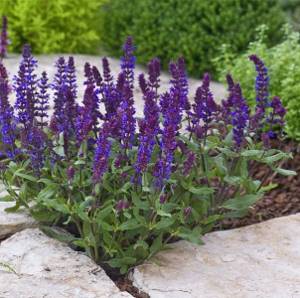
klumba.irk
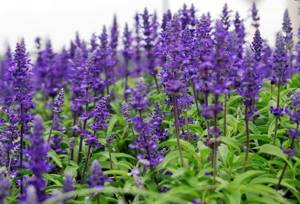
uliasav4uk
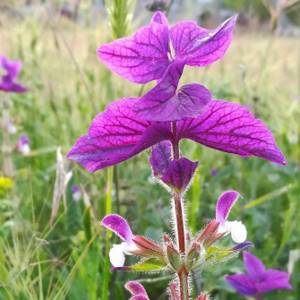
art55full

travi_chai_ua

zdravia_vsem
